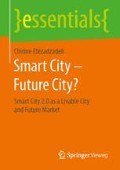Abstract
That brings us to a mega trend that has a key impact on our topics of interest: digitalization. A prerequisite for digitalization is connectivity, which requires the expansion of networks (cable-based and wireless broadband networks) and the widespread use of Web-enabled devices (PCs, portable computers, tablets, smartphones, etc.). Network rollout and the number of devices in use are rapidly increasing around the world. According to expert estimates, 40 % of the global population was already using the Internet at the end of 2014. If growth rates remain unchanged, this will hold true for 50 % of the world’s population in 2017. This is made possible especially by cable-based broadband networks (711 million connections at the end of 2014) in conjunction with a progressive expansion of fiberglass networks and a global growth rate of 1.5 % per year (expansion is expensive) as well as mobile broadband networks. While more than 6.9 billion mobile phone connections already exist today (2020: approx. 10.8 billion), the number of smartphone users is projected to climb from 1.76 to 5.6 billion users by 2019. Concomitantly, LTE market penetration is on a steep incline. In 2010, 612,000 people were using LTE, in 2011 that figure had already risen to 13.2 million, in 2012 to 100 million, and by 2016 the number of LTE users is expected to exceed 1 billion. Accordingly, more and more people have direct, high-speed Internet access both at home and when they are on the go. This serves as a basis for the digitalization of business and personal life and can lay the foundation for the breakthrough of “digital dominance.”
Access this chapter
Tax calculation will be finalised at checkout
Purchases are for personal use only
Notes
- 1.
cf. ITU (2014), p. 5.
- 2.
cf. Broadband Commission (2014), p. 12.
- 3.
cf. Broadband Commission (2014), p. 18.
- 4.
cf. ITU (2014), p. 3. According to GSMA, this figure includes M2M communication. cf. GSMA (2014), p. 54.
- 5.
cf. Broadband Commission (2014), p. 20.
- 6.
cf. Lam, W. (2013), n.p.
- 7.
cf. on the topic of self-tracking: Werle, K. (2014).
- 8.
Oxford Dictionaries (n.d.) keyword: digital detox. http://www.oxforddictionaries.com/de/definition/englisch/digital-detox. Retrieved on 01/27/2015.
- 9.
Andreessen, M. (2011).
- 10.
cf. Berners-Lee, T. (2009).
- 11.
cf. Kurzweil, R. (2005).
- 12.
cf. BITKOM, IAO (2014).
- 13.
cf. ibid.
Author information
Authors and Affiliations
Corresponding author
Rights and permissions
Copyright information
© 2016 Springer Fachmedien Wiesbaden
About this chapter
Cite this chapter
Etezadzadeh, C. (2016). Digitalization. In: Smart City – Future City?. essentials. Springer Vieweg, Wiesbaden. https://doi.org/10.1007/978-3-658-11017-8_6
Download citation
DOI: https://doi.org/10.1007/978-3-658-11017-8_6
Published:
Publisher Name: Springer Vieweg, Wiesbaden
Print ISBN: 978-3-658-11016-1
Online ISBN: 978-3-658-11017-8
eBook Packages: EngineeringEngineering (R0)

